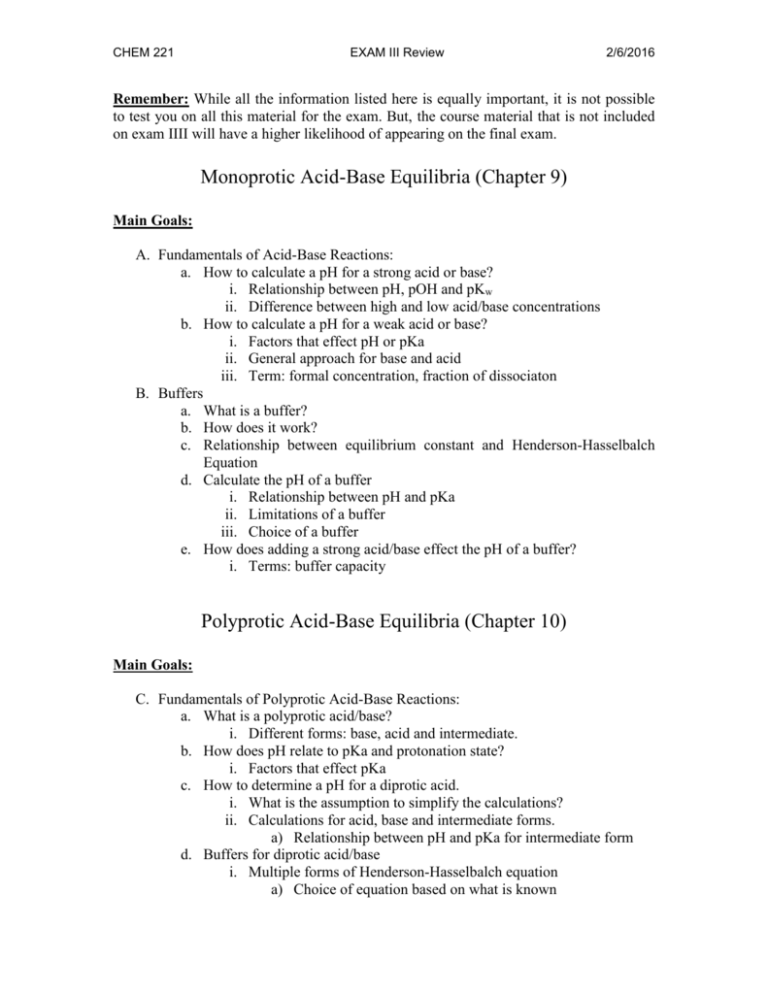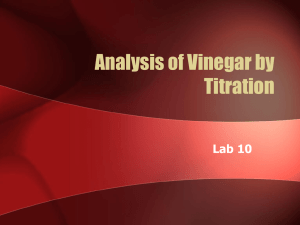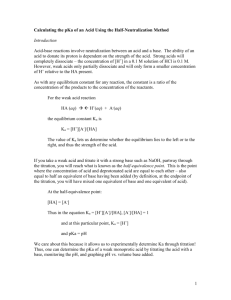Exam 3 Goals
advertisement

CHEM 221 EXAM III Review 2/6/2016 Remember: While all the information listed here is equally important, it is not possible to test you on all this material for the exam. But, the course material that is not included on exam IIII will have a higher likelihood of appearing on the final exam. Monoprotic Acid-Base Equilibria (Chapter 9) Main Goals: A. Fundamentals of Acid-Base Reactions: a. How to calculate a pH for a strong acid or base? i. Relationship between pH, pOH and pKw ii. Difference between high and low acid/base concentrations b. How to calculate a pH for a weak acid or base? i. Factors that effect pH or pKa ii. General approach for base and acid iii. Term: formal concentration, fraction of dissociaton B. Buffers a. What is a buffer? b. How does it work? c. Relationship between equilibrium constant and Henderson-Hasselbalch Equation d. Calculate the pH of a buffer i. Relationship between pH and pKa ii. Limitations of a buffer iii. Choice of a buffer e. How does adding a strong acid/base effect the pH of a buffer? i. Terms: buffer capacity Polyprotic Acid-Base Equilibria (Chapter 10) Main Goals: C. Fundamentals of Polyprotic Acid-Base Reactions: a. What is a polyprotic acid/base? i. Different forms: base, acid and intermediate. b. How does pH relate to pKa and protonation state? i. Factors that effect pKa c. How to determine a pH for a diprotic acid. i. What is the assumption to simplify the calculations? ii. Calculations for acid, base and intermediate forms. a) Relationship between pH and pKa for intermediate form d. Buffers for diprotic acid/base i. Multiple forms of Henderson-Hasselbalch equation a) Choice of equation based on what is known CHEM 221 EXAM III Review 2/6/2016 b) Solution only has one pH ii. Effect of strong acid/base on pH e. Know how to extend the treatment of pH and buffers to polyprotic systems i. Relationship between pH, pKa and protonation state ii. Know how to use fractional composition equations iii. Term: isoionic point, isoelectric point a) Relationship to pH and pKa Acid-Base Titrations (Chapter 11) Main Goals: D. Understanding the Details of an Acid-Base Titration Curve: a. Kw=Ka.Kb b. pKa = -logKa c. pH = -log[H+] d. Equilibrium equation for weak acid and base dissociation i. Ka = [H+][A-]/[HA] ii. Formal concentration (F) e. Titration of a strong acid with a strong base i. Strong acid and base completely dissociate a) Titration is simply: H+ + OH- H2O ii. How does pH change as a titrant is added? a) pH = 7 at equivalence point iii. Three regions of the titration curve a) Before, after and at equivalence point f. Titration of a weak acid with a strong base i. Reaction goes to completion a) Converts weak acid to its conjugate base ii. How does pH change as titrant is added? a) pH is NOT =7 at equivalence point iii. Four regions of the titration curve a) Before titrant is added, treat as a weak acid b) Before equivalence point, treat as a buffer 1. know Henderson Hasselbach equation c) At equivalence point, all weak acid converted to conjugate base. Treat as a weak base. 1. pH is basic d) After equivalence point, pH is determined by strong base e) Account for dilution during titration iv. Important features of a titration curve. a) Equivalence point = maximum slope (inflection point) 1. corresponds to Ve b) At minimum slope before equivalence point: 1. pH = pKa at 1/2Ve 2. Maximum buffer capacity c) Slope change depends on pKa CHEM 221 EXAM III Review smaller pKa larger slope change d) Slope change depends on [HA] 1. Higher concentration higher slope change Titration of a weak base with a strong acid i. Very similar to weak acid with strong base a) Just reversed ii. Only difference: a) Before added titrant, treat as weak base b) At equivalence point, treat as weak acid 1. pH is acidic c) pH at 1/2Ve = pKa of conjugate acid Titration of a diprotic system i. Similar to monoprotic system ii. Differences: a) Two equivalence points b) pH at first equivalence point determined by intermediate form of the diprotic acid iii. Separation of equivalence points depends on: a) Relative difference in Ka’s b) Relative strengths in Ka’s between titrant and analyte Difference between equivalence point and endpoint. i. Endpoint: marked by physical change ii. Equivalence point: equal moles of analyte and titrant Calculate equivalence volume (Ve) i. M1V1=M2V2 ii. Inverting chemical reaction Methods of Identifying equivalence points i. Visual identification of inflection point ii. Plotting first or second derivative a) 1st derivative maxima b) 2nd derivative null iii. Interpolated x-intercept from Gran plot How to choose an acid-base indicator i. Color change brackets pH at equivalence point 1. g. h. i. j. k. l. 2/6/2016 EDTA Titrations (Chapter 12) Main Goals: E. Understanding the EDTA Titration process: a. What is a complexation titration? i. Lewis acid-base titration ii. What is a chelating agent? b. What is a formation constant (Kf)? i. High Kf values for EDTA titration CHEM 221 EXAM III Review 2/6/2016 c. Important chemical features of EDTA i. 7 different acid-base forms ii. 6 different pK values iii. The most basic form (Y4-) primarily reacts with metal ion iv. The fractional composition () of Y4- is strongly pH dependent v. EDTA binds tightly to multiple metal ions a) Kf is modulated by pH 1. may need auxiliary complexing agents to prevent insoluble metal hydroxide formation 2. must bind metal ion weaker than EDTA b) Kf decreases with increasing acidity 1. Y4- decreases with increasing acidity d. Important features of an EDTA titration i. Titration needs to be buffered to treat Y4- as a constant ii. Relationship between Kf’ and Kf iii. Relationship between formal EDTA concentration and Y4iv. EDTA complex formation equilibrium constant e. Calculate EDTA titration curve i. Reaction goes to completion a) Large Kf ii. Monitor pM = -log [M] iii. Three regions a) Before equivalence point, metal ion concentration decreases proportional to added EDTA b) At equivalence point, free metal ion concentration is determined by Kf c) After equivalence point, free metal ion concentration determined by excess EDTA d) Account for dilution during titration iv. Slope of titration curve depends on Kf a) Larger Kf larger slope easier identification of equivalence point f. How to determine EDTA Endpoints i. Ion-selective electrode ii. Metal-ion indicator a) How to choose an indicator? 1. pK vs. pH of titration 2. indicator needs to be unprotonated to bind metal ion 3. lower Kf relative to EDTA b) change in color when it binds metal ion Fundamentals of Electrochemistry (Chapter 14) Main Goals: CHEM 221 EXAM III Review 2/6/2016 F. Understanding Redox Reactions: a. What is a redox reaction? b. What is reduction? i. What is an oxidizing agent? ii. What is the cathode? c. What is oxidation? i. What is a reducing agent? ii. What is the anode? d. What is electric charge (q)? i. Coulombs (C) ii. Faraday constant (F) iii. Relationship between charge and moles (q=nF) iv. What is an electric current? a) Ampere (A) e. What is electric potential (E)? i. Separation of charge ii. Relationship to free energy (G=-nFE) iii. Voltage that can be generated by chemical reaction iv. Relationship to equilibrium constant K 10 nE o 0.05916 f. Relationship between cell potential and G i. What is a galvanic cell? ii. What an electrolytic cell? iii. What is the sign of E and G for spontaneous and nonspontaneous reactions? iv. What is the potential of a cell at equilibrium? a) Potential of a cell measures how far a reaction is from equilibrium g. What are the components of an electrochemical cell? i. What is a half-cell reaction? a) Keep track of moles of electrons ii. What is a net reaction? iii. How do electrons flow? iv. What is an electrode? v. What is a salt bridge? h. Short-hand notation for representing a cell i. How to write the ½ cell reactions from the short hand notation ii. Anode to cathode (left to right) iii. Include solution concentrations (or activities) iv. Phase boundaries & salt bridges i. What is the standard reduction potential (Eo)? i. What are standard conditions? ii. How are standard reduction potentials measured? a) Standard hydrogen electrode (S.H.E.) iii. Reactions always written as reductions CHEM 221 EXAM III Review 2/6/2016 iv. As Eo increases: a) More favorable the reaction b) More readily compound is reduced c) Better oxidizing agent j. How to calculate standard cell potential (Eocell)? i. Ecell = E+ - Eii. Determine if reaction is spontaneous k. Nernst Equation i. Know Nernst equation E cell E o 0.05916 [C ]c [ D ]d log n [ A]a [ B ]b ii. Determine cell potential under non-standard conditions iii. Have to calculate potential for each ½ reaction (two calculations using the Nernst equation). iv. Need to use Ecell = E+ - Ev. Relationship to equilibrium constant









